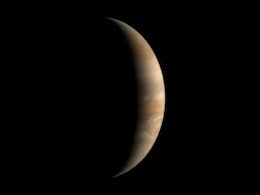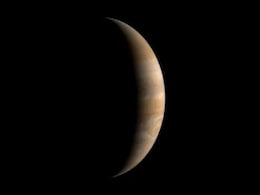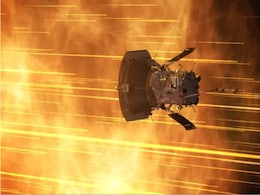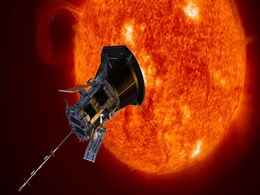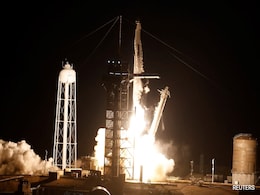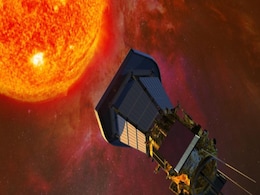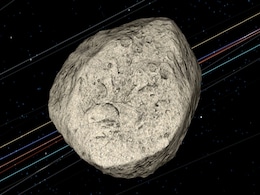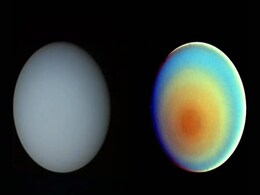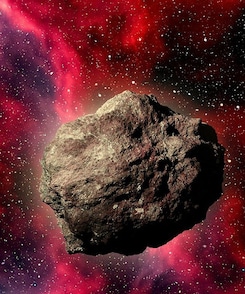Flyby
- All
- News
- Web Stories
-

James Webb Telescope Captures Neptune’s Auroras in Stunning Detail
- Monday March 31, 2025
- Written by Gadgets 360 Staff
The James Webb Space Telescope has provided the first-ever direct images of Neptune’s auroras, revealing surprising details about the ice giant’s atmosphere. Unlike auroras on Earth, Jupiter, or Saturn, Neptune’s auroras appear across unexpected locations due to its tilted and offset magnetic field. Scientists also detected the presence of H...
-
 www.gadgets360.com
www.gadgets360.com
-

NASA Confirms Asteroid 2024 YR4 Will Not Hit Earth, Risk Reduced to Zero
- Friday February 28, 2025
- Written by Gadgets 360 Staff
NASA has reassured the public that asteroid 2024 YR4 no longer poses any threat to Earth. Initially, the asteroid had a 1-in-32 chance of impact, making it a Level 3 risk on the Torino Scale. However, new observations have reduced the probability to zero. The asteroid will make close flybys in 2028 and 2032, providing scientists with an opportunity...
-
 www.gadgets360.com
www.gadgets360.com
-

Why Mumbai Is Being Linked To 'City Killer' Asteroid: All You Need To Know
- Friday February 21, 2025
- India News | Edited by Amit Chaturvedi
Dubbed "city killer", the space rock now has an estimated 1.5 per cent (or 1 in 67) chance of striking our planet during a close flyby on December 22, 2032.
-
 www.ndtv.com
www.ndtv.com
-

NASA's Juno Detects Io's Most Powerful Volcanic Eruption Yet
- Friday February 7, 2025
- Written by Gadgets 360 Staff
NASA’s Juno spacecraft has recorded the most powerful volcanic eruption on Io, Jupiter’s most volcanic moon. The eruption site, detected on 27 December 2024, is fueled by a massive magma chamber spanning 105,000 square kilometers. The heat energy released is estimated at 80 trillion watts, exceeding Earth’s total power output. The volcanic ac...
-
 www.gadgets360.com
www.gadgets360.com
-

Mysterious Interstellar Object Might Have Shifted Four Planets’ Paths, Study Finds
- Thursday January 30, 2025
- Written by Gadgets 360 Staff
A mysterious interstellar object, estimated to be eight times the mass of Jupiter, may have significantly altered the orbits of Jupiter, Saturn, Uranus, and Neptune billions of years ago. A study suggests that this body passed remarkably close to the Sun, potentially influencing planetary trajectories. Simulations conducted by researchers indicate ...
-
 www.gadgets360.com
www.gadgets360.com
-

Interstellar Object Could Have Shifted Trajectories of Four Planets, New Research Shows
- Tuesday January 21, 2025
- Written by Gadgets 360 Staff
A recent study suggests that an interstellar object, possibly as massive as eight times Jupiter, may have passed through the solar system billions of years ago, significantly altering the orbits of its outer planets—Jupiter, Saturn, Uranus, and Neptune. Using computer simulations, researchers found that in about 1% of the scenarios, such a close ...
-
 www.gadgets360.com
www.gadgets360.com
-

NASA Confirms Successful Flyby of Parker Solar Probe, Completes Closest Sun Approach
- Monday December 30, 2024
- Written by Gadgets 360 Staff
NASA's Parker Solar Probe has set an unprecedented milestone, coming 3.8 million miles from the Sun at a speed of 430,000 mph. Launched in 2018, the spacecraft has utilised Venus flybys to perfect its orbit, enabling this historic feat. With advanced technology, it endures extreme temperatures, gathering critical data about solar wind and particle ...
-
 www.gadgets360.com
www.gadgets360.com
-

Space Missions of 2025: Lunar Landings, Asteroid Sampling, and More
- Saturday December 28, 2024
- Written by Gadgets 360 Staff
Space exploration in 2025 will see remarkable missions from global agencies like NASA, ESA, China, and Japan. Key initiatives include lunar landings through NASA’s CLPS and Japan’s M2/Resilience, which will test new technologies and study lunar resources. China’s Tianwen-2 mission aims to collect asteroid samples and explore a comet, advancin...
-
 www.gadgets360.com
www.gadgets360.com
-

Parker Solar Probe's Closest Sun Flyby Sets Records, Signal Expected Soon
- Friday December 27, 2024
- Written by Gadgets 360 Staff
The Parker Solar Probe achieved the closest-ever sun flyby on Christmas Eve, reaching within 3.8 million miles of the solar surface and travelling at 430,000 miles per hour. Scientists are now waiting for a signal expected on December 27 to confirm the spacecraft’s health. Detailed telemetry and collected data are anticipated by January 1, with o...
-
 www.gadgets360.com
www.gadgets360.com
-

NASA Parker Solar Probe Makes Closest-Ever Approach to the Sun, Becomes Fastest Object Built by Humans
- Wednesday December 25, 2024
- Written by Akash Dutta, Edited by Ketan Pratap
NASA’s Parker Solar Probe made its closest-ever approach to the Sun on Tuesday, becoming the first man-made object to accomplish this feat. Parker should have travelled as close as 6.1 million kilometres to the Sun, gathering important data about its outer atmosphere. The confirmation about these feats should arrive by December 27, as the space a...
-
 www.gadgets360.com
www.gadgets360.com
-

What Time Is NASA's Parker Solar Probe Closest Sun Flyby on Christmas Eve?
- Friday December 27, 2024
- Written by Gadgets 360 Staff
On Dec. 24 at 6:53 a.m. EST, NASA’s Parker Solar Probe will achieve its closest flyby of the Sun at 3.8 million miles. The mission, part of a seven-year study, aims to uncover the mysteries of the Sun’s corona and solar wind. Travelling at 430,000 mph, the spacecraft is protected by a heat shield designed to withstand extreme temperatures. Upda...
-
 www.gadgets360.com
www.gadgets360.com
-

NASA’s Parker Solar Probe Achieves Closest Sun Flyby Ever on December 24
- Monday December 23, 2024
- Written by Gadgets 360 Staff
NASA’s Parker Solar Probe will make its closest-ever flyby of the sun on December 24, 2024, passing within 3.8 million miles of the solar surface at a speed of 430,000 mph. This marks the 22nd close encounter of the spacecraft’s mission, which aims to provide unprecedented insights into the sun’s corona and other solar phenomena. Despite extr...
-
 www.gadgets360.com
www.gadgets360.com
-

Parker Solar Probe to Break Records with Historic Sun Flyby on December 24
- Friday December 13, 2024
- Written by Gadgets 360 Staff
NASA's Parker Solar Probe is set for a record-breaking approach to the sun on December 24, travelling at 430,000 mph and reaching within 3.8 million miles of the surface. The spacecraft, equipped with advanced heat shields, will navigate solar plasma plumes and potentially an active eruption during this phase of heightened solar activity. This flyb...
-
 www.gadgets360.com
www.gadgets360.com
-

Apophis Asteroid Flyby in 2029: Earth's Gravitational May Impact Asteroid's Surface
- Thursday November 14, 2024
- Written by Gadgets 360 Staff
Asteroid 99942 Apophis, named after the ancient Egyptian god of darkness, is set to pass incredibly close to Earth in 2029, at just 32,000 km. While there is no risk of a collision, scientists are keen to study the asteroid’s interaction with Earth's gravity. Research led by planetary scientist Ronald Ballouz suggests that this flyby may cause si...
-
 www.gadgets360.com
www.gadgets360.com
-

Voyager 2's Historic Flyby of Uranus Exposes Rare Magnetic Distortion
- Tuesday November 12, 2024
- Written by Gadgets 360 Staff
A new analysis of Voyager 2’s flyby of Uranus in 1986 reveals a unique magnetic anomaly caused by a rare solar wind event. Scientists from NASA's Jet Propulsion Laboratory and Caltech found that the solar wind’s impact on Uranus’s magnetosphere was a unique occurrence, influencing measurements of the planet’s magnetic field. The study also ...
-
 www.gadgets360.com
www.gadgets360.com
-

James Webb Telescope Captures Neptune’s Auroras in Stunning Detail
- Monday March 31, 2025
- Written by Gadgets 360 Staff
The James Webb Space Telescope has provided the first-ever direct images of Neptune’s auroras, revealing surprising details about the ice giant’s atmosphere. Unlike auroras on Earth, Jupiter, or Saturn, Neptune’s auroras appear across unexpected locations due to its tilted and offset magnetic field. Scientists also detected the presence of H...
-
 www.gadgets360.com
www.gadgets360.com
-

NASA Confirms Asteroid 2024 YR4 Will Not Hit Earth, Risk Reduced to Zero
- Friday February 28, 2025
- Written by Gadgets 360 Staff
NASA has reassured the public that asteroid 2024 YR4 no longer poses any threat to Earth. Initially, the asteroid had a 1-in-32 chance of impact, making it a Level 3 risk on the Torino Scale. However, new observations have reduced the probability to zero. The asteroid will make close flybys in 2028 and 2032, providing scientists with an opportunity...
-
 www.gadgets360.com
www.gadgets360.com
-

Why Mumbai Is Being Linked To 'City Killer' Asteroid: All You Need To Know
- Friday February 21, 2025
- India News | Edited by Amit Chaturvedi
Dubbed "city killer", the space rock now has an estimated 1.5 per cent (or 1 in 67) chance of striking our planet during a close flyby on December 22, 2032.
-
 www.ndtv.com
www.ndtv.com
-

NASA's Juno Detects Io's Most Powerful Volcanic Eruption Yet
- Friday February 7, 2025
- Written by Gadgets 360 Staff
NASA’s Juno spacecraft has recorded the most powerful volcanic eruption on Io, Jupiter’s most volcanic moon. The eruption site, detected on 27 December 2024, is fueled by a massive magma chamber spanning 105,000 square kilometers. The heat energy released is estimated at 80 trillion watts, exceeding Earth’s total power output. The volcanic ac...
-
 www.gadgets360.com
www.gadgets360.com
-

Mysterious Interstellar Object Might Have Shifted Four Planets’ Paths, Study Finds
- Thursday January 30, 2025
- Written by Gadgets 360 Staff
A mysterious interstellar object, estimated to be eight times the mass of Jupiter, may have significantly altered the orbits of Jupiter, Saturn, Uranus, and Neptune billions of years ago. A study suggests that this body passed remarkably close to the Sun, potentially influencing planetary trajectories. Simulations conducted by researchers indicate ...
-
 www.gadgets360.com
www.gadgets360.com
-

Interstellar Object Could Have Shifted Trajectories of Four Planets, New Research Shows
- Tuesday January 21, 2025
- Written by Gadgets 360 Staff
A recent study suggests that an interstellar object, possibly as massive as eight times Jupiter, may have passed through the solar system billions of years ago, significantly altering the orbits of its outer planets—Jupiter, Saturn, Uranus, and Neptune. Using computer simulations, researchers found that in about 1% of the scenarios, such a close ...
-
 www.gadgets360.com
www.gadgets360.com
-

NASA Confirms Successful Flyby of Parker Solar Probe, Completes Closest Sun Approach
- Monday December 30, 2024
- Written by Gadgets 360 Staff
NASA's Parker Solar Probe has set an unprecedented milestone, coming 3.8 million miles from the Sun at a speed of 430,000 mph. Launched in 2018, the spacecraft has utilised Venus flybys to perfect its orbit, enabling this historic feat. With advanced technology, it endures extreme temperatures, gathering critical data about solar wind and particle ...
-
 www.gadgets360.com
www.gadgets360.com
-

Space Missions of 2025: Lunar Landings, Asteroid Sampling, and More
- Saturday December 28, 2024
- Written by Gadgets 360 Staff
Space exploration in 2025 will see remarkable missions from global agencies like NASA, ESA, China, and Japan. Key initiatives include lunar landings through NASA’s CLPS and Japan’s M2/Resilience, which will test new technologies and study lunar resources. China’s Tianwen-2 mission aims to collect asteroid samples and explore a comet, advancin...
-
 www.gadgets360.com
www.gadgets360.com
-

Parker Solar Probe's Closest Sun Flyby Sets Records, Signal Expected Soon
- Friday December 27, 2024
- Written by Gadgets 360 Staff
The Parker Solar Probe achieved the closest-ever sun flyby on Christmas Eve, reaching within 3.8 million miles of the solar surface and travelling at 430,000 miles per hour. Scientists are now waiting for a signal expected on December 27 to confirm the spacecraft’s health. Detailed telemetry and collected data are anticipated by January 1, with o...
-
 www.gadgets360.com
www.gadgets360.com
-

NASA Parker Solar Probe Makes Closest-Ever Approach to the Sun, Becomes Fastest Object Built by Humans
- Wednesday December 25, 2024
- Written by Akash Dutta, Edited by Ketan Pratap
NASA’s Parker Solar Probe made its closest-ever approach to the Sun on Tuesday, becoming the first man-made object to accomplish this feat. Parker should have travelled as close as 6.1 million kilometres to the Sun, gathering important data about its outer atmosphere. The confirmation about these feats should arrive by December 27, as the space a...
-
 www.gadgets360.com
www.gadgets360.com
-

What Time Is NASA's Parker Solar Probe Closest Sun Flyby on Christmas Eve?
- Friday December 27, 2024
- Written by Gadgets 360 Staff
On Dec. 24 at 6:53 a.m. EST, NASA’s Parker Solar Probe will achieve its closest flyby of the Sun at 3.8 million miles. The mission, part of a seven-year study, aims to uncover the mysteries of the Sun’s corona and solar wind. Travelling at 430,000 mph, the spacecraft is protected by a heat shield designed to withstand extreme temperatures. Upda...
-
 www.gadgets360.com
www.gadgets360.com
-

NASA’s Parker Solar Probe Achieves Closest Sun Flyby Ever on December 24
- Monday December 23, 2024
- Written by Gadgets 360 Staff
NASA’s Parker Solar Probe will make its closest-ever flyby of the sun on December 24, 2024, passing within 3.8 million miles of the solar surface at a speed of 430,000 mph. This marks the 22nd close encounter of the spacecraft’s mission, which aims to provide unprecedented insights into the sun’s corona and other solar phenomena. Despite extr...
-
 www.gadgets360.com
www.gadgets360.com
-

Parker Solar Probe to Break Records with Historic Sun Flyby on December 24
- Friday December 13, 2024
- Written by Gadgets 360 Staff
NASA's Parker Solar Probe is set for a record-breaking approach to the sun on December 24, travelling at 430,000 mph and reaching within 3.8 million miles of the surface. The spacecraft, equipped with advanced heat shields, will navigate solar plasma plumes and potentially an active eruption during this phase of heightened solar activity. This flyb...
-
 www.gadgets360.com
www.gadgets360.com
-

Apophis Asteroid Flyby in 2029: Earth's Gravitational May Impact Asteroid's Surface
- Thursday November 14, 2024
- Written by Gadgets 360 Staff
Asteroid 99942 Apophis, named after the ancient Egyptian god of darkness, is set to pass incredibly close to Earth in 2029, at just 32,000 km. While there is no risk of a collision, scientists are keen to study the asteroid’s interaction with Earth's gravity. Research led by planetary scientist Ronald Ballouz suggests that this flyby may cause si...
-
 www.gadgets360.com
www.gadgets360.com
-

Voyager 2's Historic Flyby of Uranus Exposes Rare Magnetic Distortion
- Tuesday November 12, 2024
- Written by Gadgets 360 Staff
A new analysis of Voyager 2’s flyby of Uranus in 1986 reveals a unique magnetic anomaly caused by a rare solar wind event. Scientists from NASA's Jet Propulsion Laboratory and Caltech found that the solar wind’s impact on Uranus’s magnetosphere was a unique occurrence, influencing measurements of the planet’s magnetic field. The study also ...
-
 www.gadgets360.com
www.gadgets360.com





